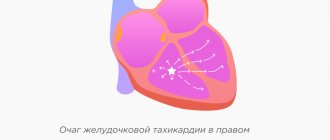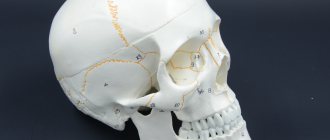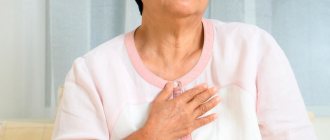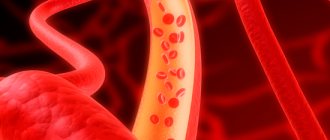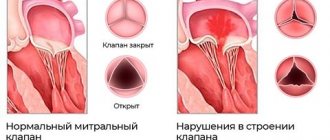The symptom complex of vegetative-vascular dystonia includes many manifestations that affect the functioning of almost all organs. Extrasystole with VSD is a very common symptom and accompanies almost every VSD patient. It is exclusively neurological in nature and in most cases does not threaten the patient’s life, but it brings a lot of inconvenience and leads to an exacerbation of the disease.
What is characteristic of vegetative-vascular dystonia
It is important for a VSD patient to understand that his arrhythmia is of a functional nature. And no matter where exactly and in what quantity it occurs, one thing is clear: the heart is healthy, and the reason lies in something completely different.
Extrasystole in such patients manifests itself when a large amount of adrenaline enters the blood. But as soon as it decreases to normal, all sensations subside. That is, the problem is temporary and reversible. But patients tolerate it very hard. For them, this is like death: heart failures catch them suddenly, they can be repeated for several months and even years, until the cause is eliminated.
At this moment, a person is seized by a feeling of fear. He begins to choke, his legs give way, and he may lose consciousness. The patient becomes pale, begins to rush about, and scream. The sensation in the chest resembles a blow to the rib cage.
An even greater fear is the compensatory break after an extraordinary compression. The patient fears that his heart will stop. It seems to him that he will die, and this cannot be avoided.
If the excitement intensifies, then the symptoms worsen. Atrial fibrillation occurs. It seems that the heart works outside the regime, chaotically, as it pleases. Fortunately, this condition rarely occurs.
Types of pathology
The most common classification of the disease takes into account the reasons for the development of extrasystole in patients. Doctors distinguish functional, organic and toxic forms of pathology. An alternative typology is based on the localization of ectopic foci of excitation and allows us to distinguish four types of heart rhythm disturbances:
- ventricular (62% of clinically diagnosed cases);
- atrioventricular (2%);
- atrial (10%);
- sinoatrial (0.2%).
An important diagnostic sign is the frequency of extrasystoles in the patient. Seizures occurring no more than 5 times per minute are considered rare. The average frequency is recorded at 6–15 extrasystoles per minute, high - at 16 or more.
Why do extrasystoles occur during VSD?
Cardiac “dancing” in vegetative-vascular dystonia can occur when both parts of the autonomic nervous system are disrupted.
If the sympathetic department fails, extrasystoles appear after physical exertion. They are poorly controlled by sedatives, and may even intensify after taking them.
If the functioning of the parasympathetic system is disrupted, in addition to cardiac symptoms, digestive disorders are of concern: epigastric pain, diarrhea, bloating. A cup of coffee or sweet tea or a brisk walk will help relieve such an attack.
If the cause is psychological, treatment measures are directed in the other direction.
Most often, dystonics are bothered by two types of extrasystole:
- Ventricular. Usually makes itself felt in the first half of the day. It is caused by disturbances in mental balance, for example, great joy or grief. It also appears when the weather changes or when drinking strong drinks. Other provoking factors include magnesium and calcium deficiency, osteochondrosis. It all starts with an intense beat in the heart area, followed by a pause. The patient becomes covered in cold, sticky sweat and develops a feeling of fear. Despair sets in, he cannot choose a comfortable position for himself, becomes numb or begins to fuss. The violence of his heart leads him into an uncontrollable state, causing him a lot of suffering.
- Supraventricular. The most common type of arrhythmia in VSD. The causes of this condition coincide with those of the ventricular form. In addition, dystonics who are addicted to antiarrhythmic and diuretic drugs are at risk. Patients claim that the condition worsens when lying down. It is this sign that indicates that the cardiac failure is functional in nature.
Diagnostic measures
Diagnosis of extrasystole takes place in two stages. During the first, the cardiologist examines the patient and collects objective data for anamnesis. The second stage involves men and women undergoing cardiac tests.
Confirmation of the preliminary diagnosis is carried out during ECG and 24-hour Holter monitoring. These methods make it possible to detect extrasystole in the absence of obvious symptoms of pathology in the patient. Heart rhythm disturbances that do not manifest themselves at rest are recorded during a treadmill test and bicycle ergometry. Ultrasound and MRI of the heart are used as additional diagnostic methods.
Extrasystole and other signs of VSD
Considering that extrasystoles cause severe discomfort to dystonics and knock them out of their normal state, they become the cause of the development of other symptoms of VSD. These include:
- increased sweating;
- irritation;
- worry and anxiety;
- weakness and malaise;
- chills and feeling of heat.
Panic attacks that occur during heart dances become the basis for the formation of cardioneurosis. A dystonic person risks developing a phobia against the background of such interruptions in the heart.
Attacks of arrhythmia that occur at night disturb the sleep of the sufferer and provoke insomnia. It can also accompany him as a result of constant worry and anxiety.
Extrasystoles in neurocirculatory dystonia, despite their harmlessness, cause circulatory disorders, including cerebral circulation. As a result, the patient experiences attacks of suffocation, lack of air, and dizziness. Shortness of breath appears.
One of the complications provoked by extraordinary heart contractions during VSD is a panic attack. It begins with an attack of panic and fear, accompanied by a feeling of anxiety and tension. Other symptoms include tachycardia, internal trembling and sweating, nausea, suffocation and dizziness. Characterized by unpleasant sensations in the heart area, tingling and numbness of the arms and legs. The panicker is overcome by fear of death, consciousness is confused, and thinking is impaired.
Thus, arrhythmia, being a sign of VSD, provokes the development of other symptoms of the disease and aggravates its course.
General information
The pathology develops against the background of early depolarization of the atria, ventricles or atrioventricular junction. Due to these disorders, the patient's heart contracts prematurely. Isolated cases of extrasystoles can occur in healthy people of any age group.
Most often, signs of extrasystole are detected in men and women over 50 years of age. The disease causes a decrease in coronary and cerebral blood flow. With a complicated course of the pathology, patients may experience cerebrovascular accidents and atrial fibrillation.
Prognosis and prevention
The nature of the prognosis formed by the cardiologist depends on the form of pathology diagnosed in the patient. The least favorable cases are heart rhythm disturbances that occur against the background of myocardial infarction, cardiomyopathy and myocarditis. Changes in myocardial tissue can provoke atrial fibrillation. The absence of organic heart lesions allows doctors to formulate a favorable prognosis for 85–90% of patients.
A set of preventive measures is aimed at preventing diseases that provoke heart rhythm disturbances: coronary heart disease, cardiomyopathies, myocarditis, etc. Patients of all age groups are recommended to regularly undergo preventive examinations in clinics, visit a therapist, cardiologist, neurologist and doctors of other specializations.
People at risk are advised to exercise moderately and avoid drinking drinks high in caffeine and ethanol.
Ventricular extrasystole
Extrasystole Good afternoon. Please help me understand whether it is worth treating my extrasystoles. I am 28 years old. Previously, I rarely felt my heart sink; I did an ECG and they said everything was fine. After the stress I suffered (my husband had pneumonia, then I), I began to feel frozen again. I contacted a cardiologist. Ultrasound result: Aorta 28mm (up to 37mm) ascending section 24mm. Left atrium 37mm (up to 40mm) Left ventricle: IVS 7mm (up to 11mm) ES 7 mm (up to 11mm) MM 105g IMM 65 (m 115/f95) g/m EDR 46mm (up to 58mm) EDV 90 ml (m 170/f100ml) ) KSO 38ml FB Simpson 60% (>55%) Kinetics are not affected. Inferior vena cava 17 mm collapses more than 50% Aortic valve: leaflets are not sealed Vmax 1.60 m/s (up to 1.7 m/s) Mitral valve: leaflets are not changed Ve 0.9 m/s (up to 1.3 m/s) Va 0.6 m/s Tdec 166ms (160-240 ms) regurgitation 1st degree. Tricuspid valve: leaflets are not changed Vmax 0.58 m/s (up to 0.7 m/s) Pulmonary valve Vmax 0.9 m/s CONCLUSION: The chambers of the heart are not dilated. The walls of the LV are not thickened. Myocardial mass is not increased. Zones of local contractility impairment are not reliably determined. Global LV contractility is not reduced. (Simpson BP 60%) Diastolic function is not impaired. Global RV systolic function is not reduced (TAPSE> 1.7 mm) The aorta is not dilated. The aortic valve is tricuspid, the leaflets are not sealed, their opening is not limited. Blood flow is not accelerated. The mitral valve leaflets are not changed. Mitral regurgitation stage 1. The tricuspid valve is not changed. The EVP is not expanded, collapsing on inspiration more than 50%. The pericardium is without features. The MSP and MZH are located along the entire length. CONCLUSION ON HOLTER: For the time of Holt. monitoring, which lasted 23 hours 59 minutes, sinus rhythm was recorded. Daily dynamics of heart rate - moderate tachycardia during the day. , the chronotropic growth rate for the performed loads is high, the degree of night-time decrease in heart rate is sufficient (CI - 1.32). Heart rate avg. per day - 91 beats/min, heart rate avg. during the day 102 beats/min, heart rate Wed, at night - 77 beats/min, ycCain 52 beats/min (08:50, sleep), YCC max 188 beats/min (16:34, climbing stairs) Against the background of this rhythm, the following was recorded: 1. Single ventricular ectopic activity of class 4 B according to M. Ryan: - single monomorphic ventricular extrasystole - 390 VE, incl. h. single drainage complexes; — paired polymorphic ventricular extrasystole — 1 pair; Total - 392 VE, 0-42 per hour, mixed distribution; 2. Sutraventricular ectopic activity was not recorded. 3. Clinically significant pauses were not recorded. Max pause RR - 1.4 sec at 09:18; 4, QT dynamics: QT max 451 ms. QT corrected avg. 422 ms (in normal threads); 5. no ischemic episodes were registered (heart rate = 97% of the maximum for a given age was achieved; 6. Heart rate variability is normal. The cardiologist said that this extrasystole MUST be treated and prescribed potassium and magnesium drips for 14 thousand rubles, naturally in their clinic. But at the same time she didn’t tell me to donate blood for potassium and magnesium, she assured me that it was safe. I took 3 droppers, tolerated them quite poorly. Fear during the time, a broken state for the whole day after, pale face, tingling in the arms and legs, as well as in other parts of the body. I donated blood for potassium and magnesium - everything was within normal limits. Doubts arose and I turned to another cardiologist, she said that my extrasystoles were not scary and that the autonomic nervous system should be treated. She suggested reflex therapy, again in their clinic. Please help me understand who I should trust from these doctors, whether I need to worry about my extrasystoles and treat them. Thank you very much in advance for your answer.
Characteristic signs of a violation
It is quite difficult to miss the occurrence of the problem in question. Typically, patients complain of a number of characteristic symptoms that almost certainly indicate the presence of the indicated problem.
The most noticeable symptoms of extrasystole are the following:
- Feeling of heaviness behind the sternum.
- Feeling a push in the heart.
- Feeling of cardiac arrest.
- Difficulty breathing.
- Pulsation in the temporal region.
- The appearance of pulse fluttering, followed by tremors.
Along with the listed symptoms, the patient may experience dizziness, nausea, and an inexplicable feeling of anxiety. Having noticed such manifestations, it is imperative to consult a specialist. Extrasystole cannot always be considered safe. In many cases, such a violation can lead to serious complications. Therefore, this pathological condition must be controlled.
Treatment
The treatment tactics for extrasystole are determined by a cardiologist, taking into account the form of the disease diagnosed in a man or woman. The development of heart rhythm disturbances against the background of pathologies of the digestive or endocrine systems will require the patient to contact a gastroenterologist or endocrinologist.
Neurogenic types of the disease are treated with sedatives. If the pathology is toxic, the cardiologist cancels or reduces the dose of drugs that lead to heart rhythm disturbances.
Drug therapy is based on antiarrhythmic drugs. The duration of the course ranges from 4 to 8 weeks. The daily dose of drugs received by the patient gradually decreases as the frequency of extrasystoles decreases.
Radiofrequency ablation is performed when the effectiveness of drug therapy is low. Electrodes are inserted into the patient's heart cavity (through punctures in the femoral vein or artery). Radiofrequency pulses affect arrhythmogenic zones and normalize their condition.
